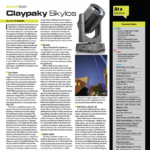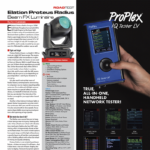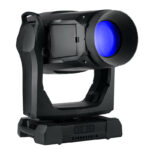The Igloo dome is a protective device designed to protect the smaller series of light fixtures from Clay Paky (as well as other manufacturers) against the elements. Physically resembling its name, this device can offer a full IP54 protection from the wet weather, sweltering sun as well as dust and wind.
Three Models
There are three different models to choose from. One is the Igloo ECO model, a simple, tightly sealed dome enclosure with two exterior power and DMX cables to pass into connectors on the inside for the light fixture. Next is the mid-level fixture called The Igloo EASY. It is similar to the ECO dome but provides environmental controls. Lastly, Clay Paky offers the Igloo WL, which is a smart version that comes equipped with a wireless DMX (WDMX3) unit inside along with climate control capabilities. I will be testing the smart version here.
These units are perfect for setting lights on top of buildings, in forests, and other hard-to-get-to places, as I will explain later. They could be used in any weather condition, ranging from freezing cold to sweltering summer days. Snow, rain and summer humidity are not an issue due to the internal fan and its climate-control capability. The temperature inside the dome is regulated by an automatic cooling and heating system that maintains a constant operational temperature between 32° and 95° F.
Lightweight yet Sturdy
The first thing I notice when I take the Igloo out of the large case is that it is very sturdy, yet does not weigh a ton. There are four handles that make it simple for two of us to move the 66-pound dome. It’s just about three feet high by three feet wide, if you include the curved exhaust spigot that extends out from the base to dispense heat from the dome.
I am able to remove the cover easily without any tools. The gasket between the base and the clear cover ensures that it remains watertight. This clear dome is made of a UV-resistant polycarbonate material, It’s not glass, nor does it feel like plastic. It is rock hard and appears to be scratch resistant. The heat from a Sharpy being mere inches away will not melt or distort the transparency of the dome itself.
The base is black stainless steel with four screw-jack types of feet allowing you to adjust the level. This model came with a single L6-20 AC connector on it. The other models come equipped with two separate AC inputs, one for the fixture and the other for internal controls. The power input on each of these models must be configured to either 100-120V or 200-240V.
The Igloo was made to accommodate small fixtures ranging in size from the Clay Paky Alpha 700, Alpha 300 Sharpy series, Mythos and A.Leda series of fixtures. It will also accommodate any other manufacturer’s fixtures of a similar size. I place a Sharpy inside to test it.
Control Nuances
As noted, the version of Igloo tested here is equipped with a WDMX-3 wireless receiver. It is important to also note that, on this model, the light fixture will not receive any AC to power up until it gets a DMX command signal. I notice that I must hit a tiny button on the wireless receiver for it to recognize and accept the wireless signal. Once the wireless receiver has recognized the transmitter, it remembers the signal’s origin after the Igloo has been turned off for any reason. I see that the two are talking.
One must address the wireless DMX, because the Igloo actually needs one channel of DMX itself. So I address the WDMX box through dipswitches to be #1. I then address the Sharpy fixture inside the dome to #2. As soon as I tell channel one to be at full on the console, the Sharpy receives power and the light fires up.
Mind you, there are three separate commands on one channel with the Igloo. At full, the dome allows voltage to go to the fixture inside. At zero percent, the dome is Idle and the power keeps going to the fixture. But in between zero and full is a certain range where power to the fixture will shut off, dousing the light.
This is a good but somewhat dangerous feature for a programmer. If you are programming at night and need to stop when the sun rises, you simply douse the lamps, then kill power to the Igloo and your console. When the console fires up the next day, you just need to bring that one channel to full and then park the channel. The downside of this feature is that if you do not park the channel at full, and decide to pull the fader or the Grand Master down half way at any point in a show, you will extinguish all the fixtures in all your domes.
Climate Control
I play with the Sharpy and notice that the base is slightly above the actual clear dome. This means that, at full tilt, the dome is not blocking the actual beam at any time. The light beam coming out of the dome does not appear diffused or to lose any lumens, despite shooting through the curved clear shell.
The temperature inside is regulated, so the lowest temp is never below freezing (32°F) nor sweltering (90°F). A well-protected large fan is mounted underneath the fixture to blow exterior air into the dome. It’s about 85° in the warehouse currently, so it does not take long for the Sharpy to heat up the Igloo when I turn the lamp on.
The fan is not overly loud, but I can hear it when it kicks on. It certainly would not be noticeable anywhere outdoors. There is an exhaust pipe extruding from the side. The fan turns off after a few minutes by itself once it’s cooled down. There are heating elements inside for winter conditions as well.
I think these are perfect devices for architectural installs as well as temporary outdoor shows. I can picture using a couple of these in the back of a pickup truck to light a grand opening of a new establishment. Imagine putting a few dozen of these on tops of various city rooftops and creating a dazzling light show for your town.
At a Glance
Clear and Weatherproof
No matter what the weatherman predicts, the forecast for compact fixtures housed within Clay Paky’s Igloo dome enclosures is always the same: clear and mild. Designed to protect gear from extreme temperatures as well as rain, dust and wind, the IP54-rated enclosures also ensure that the beams from within will shine out without undue dimming or distortion.
Clay Paky Igloo
PROS: Provides excellent protection against the elements, ability to turn on and off power from the console, wireless DMX onboard.
CONS: Fixture could use a separate, additional DMX channel to the fixture that turns it off.
STATS:
Size: 35.6” x 27.32” x 35.7” (WxDxH)
Weight: 66 lbs.
Prices (MSRP):
- Igloo WL: $4,375
- Igloo Easy: $3,550
- Igloo ECO: $3,050
SPECS:
Power Supplies:
100-120V 50/60Hz
200-240V 50/60Hz
Input Power:
150VA a 230V 50Hz (Igloo)
Max 1200VA a 230V 50Hz (Projector)
Control & Programming:
Input: DMX 512 / wireless
Body:
Stainless steel structure with plastic pressure casting covers.
Four side handles for transportation.
IP54 protection rating (Protected against dust and Protected against splashing)
More Info: www.claypaky.it



